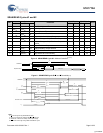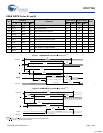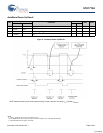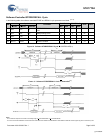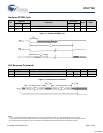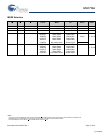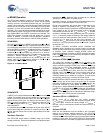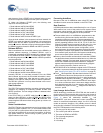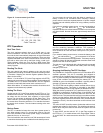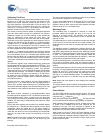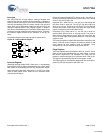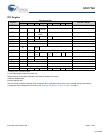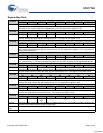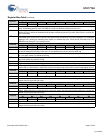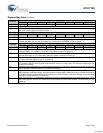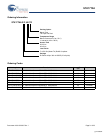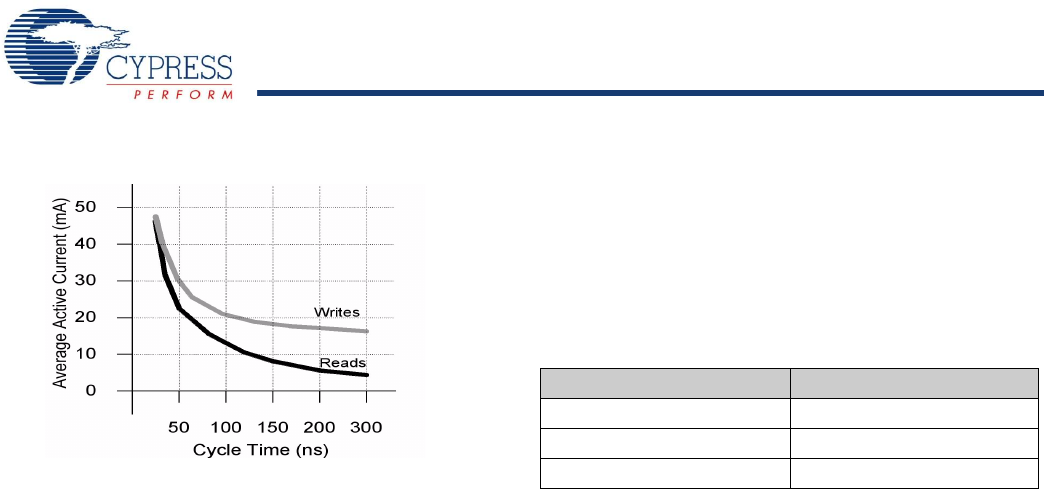
STK17TA8
Document #: 001-52039 Rev. ** Page 14 of 23
Figure 15. Current versus Cycle Time
RTC Operations
Real Time Clock
The clock registers maintain time up to 9,999 years in one
second increments. The user can set the time to any calendar
time and the clock automatically keeps track of days of the week
and month, leap years, and century transitions. There are eight
registers dedicated to the clock functions which are used to set
time with a write cycle and to read time during a read cycle.
These registers contain the Time of Day in BCD format. Bits
defined as "0" are currently not used and are reserved for future
use by Cypress.
Reading The Clock
The user should halt internal updates to the real time clock
registers before reading clock data to prevent the reading of data
in transition. Stopping the internal register updates does not
affect clock accuracy.
Write a “1” to the read bit "R" (in the Flags register at 0x1FFF0)
captures the current time in holding registers. Clock updates will
not restart until a “0” is written to the read bit. The RTC registers
can then be read while the internal clock continues to run.
Within 20ms after a “0” is written to the read bit, all real time clock
registers are simultaneously updated.
Setting The Clock
Set the write bit “W” (in the Flags register at 0x1FFF0) to a "1" to
enable the time to be set. The correct day, date and time can then
be written into the real time clock registers in 24-hour BCD
format. The time written is referred to as the "Base Time." This
value is stored in nonvolatile registers and used in calculation of
the current time. Reset the write bit to "0" to transfer the time to
the actual clock counters. The clock starts counting at the new
base time.
Backup Power
The RTC in intended to keep time even when system power is
lost. When primary power, V
CC
, drops below V
SWITCH
, the real
time clock switches to the backup power supply connected to
either the V
RTCcap
or V
RTCbat
pin.
The clock oscillator uses a maximum of 300 nanoamps at 2 volts
to maximize the backup time available from the backup source.
You can power the real time clock with either a capacitor or a
battery. Factors to be considered when choosing a backup
power source include the expected duration of power outages
and the cost and reliability trade-off of using a battery versus a
capacitor.
If you select a capacitor power source, connect the capacitor to
the V
RTCcap
pin and leave the V
RTCbat
pin unconnected.
Capacitor backup time values based on maximum current specs
are shown below. Nominal times are approximately three times
longer.
A capacitor has the obvious advantage of being more reliable
and not containing hazardous materials. The capacitor is
recharged every time the power is turned on so that real time
clock continues to have the same backup time over years of
operation.
If you select a battery power source, connect the battery to the
V
RTCbat
pin and leave the V
RTCcap
pin unconnected. A 3V lithium
battery is recommended for this application. The battery capacity
should be chosen for the total anticipated cumulative down-time
required over the life of the system.
The real time clock is designed with a diode internally connected
to the V
RTCbat
pin. This prevents the battery from ever being
charged by the circuit.
Stopping And Starting The RTC Oscillator
The OSCEN bit in Calibration register at 0x1FFF8 enables RTC
oscillator operation. This bit is nonvolatile and shipped to
customers in the “enabled” state (set to 0). OSCEN should be set
to a 1 to preserve battery life while the system is in storage. This
turns off the oscillator circuit extending the battery life. If the
OSCEN bit goes from disabled to enabled, it typically takes 5
seconds (10 seconds max) for the oscillator to start.
The STK17TA8 has the ability to detect oscillator failure due to
loss of backup power. The failure is recorded by the OSCF
(Oscillator Failed) bit of the Flags register (at address 0x1FFF0).
When the device is powered on (V
CC
goes above V
SWITCH
), the
OSCEN bit is checked for "enabled" status. If the OSCEN bit is
enabled and the oscillator is not active within the first 5 ms, the
OSCF bit is set. The user should check for this condition and then
write a 0 to clear the flag. When the OSCF flag bit is set, the real
time clock registers are reset to the “Base Time” (see the section
"Setting the Clock"), the value last written to the real time clock
registers.
The value of OSCF should be reset to 0 when the real time clock
registers are written for the first time. This initializes the state of
this bit which may have become set when the system was first
powered on.
To reset OSCF, set the write bit “W” (in the Flags register at
0x1FFF0) to a "1" to enable writes to the Flag register. Write a
“0” to the OSCF bit. and thenreset the write bit to "0" to disable
writes.
Capacitor Value Backup Time
0.1 F 72 hours
0.47 F 14 days
1.0 F 30 days
[+] Feedback



